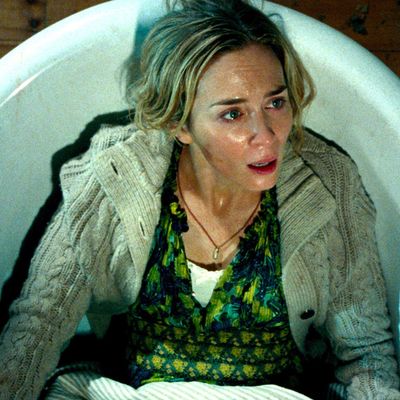
* This post includes spoilers for A Quiet Place.
John Krasinski was not a likely candidate to direct one of the year’s most anticipated horror films, and yet, A Quiet Place premiered at this year’s SXSW festival to jubilant reviews, earning a near perfect critical rating as it sails into its opening weekend — where it’s slated to take the top box-office spot from Steven Spielberg’s gargantuan Ready Player One. So how did the Jim from Dunder Mifflin pull off this critical and box-office coup? By making a pure hit of horror adrenaline shot straight into the mainline.
The script, which Krasinski rewrote from a first draft by Scott Beck and Bryan Woods, is a well-executed study in tension, and it’s given emotional heft by the onscreen dynamic he shares with his real-life partner, Emily Blunt. Together they play Evelyn and Lee, married parents of two with a baby on the way, who are doing everything they can to make a good life for their children — while keeping them safe from lightning-fast monsters that seem to have overrun the whole planet. But the real kick of A Quiet Place is its perfect driving conceit: The monsters hunt by sound, and anything above whisper decibel will draw them in.
It’s almost too obvious to say, but sound is central to horror. If those screeching strings hadn’t been playing over the top of Norman Bates stabbing Marion Crane, would we even be talking about Psycho today? And so it follows that the absence of noise is just as important. When no one is making a sound in a horror movie, you hold your breath, lest you tip off the killer all the way from the other side of the screen. Krasinski blew that feeling up and turned it into an entire plot: When making noise anywhere at any time is life-threatening, an egg timer is enough to bring down life as you know it. It makes sense, then, that the movie’s best scene is one that includes an inopportunely placed nail and a woman going into contractions.
Evelyn is nine months pregnant, because A Quiet Place wasn’t stressful enough without labor and the threat of a screaming newborn. The film starts with a “normal” evening of chores for Evelyn, when the absolute worst thing happens: With her husband and children out of the house, Evelyn’s water breaks. She instinctively heads for the AV command center in the basement of the house to fire up the SOS signal (a strand of red globe lights that snake across the property), and on her way down the old wooden stairs, Blunt’s character lands with the full weight of her step on an upright nail. Everyone in A Quiet Place goes shoeless to mitigate noise, meaning the spike instantly buries itself several inches into Evelyn’s exposed foot. With the sonic stakes extraordinarily high, that cursed nail becomes “as lethal as an unexploded bomb,” as the New York Times put it.
Evelyn stifles a scream, but drops a picture frame on the floor, resulting in an audible shatter. And now we know all hell is going to come down on her. One of the beasts enters the home and makes its way downstairs, leaving bleeding, birthing, horrified Evelyn to bury herself silently in a corner until her improvised trap — a kitchen timer — goes off, distracting the monster long enough for her to exit up the stairs. If you broke this scene out as a short film from A Quiet Place, it could stand on its own. It makes the movie’s figurative claustrophobia literal, compressing the action into a single, small concrete room. Krasinski’s script doesn’t try to overwhelm you with blood, so the nail in the foot really delivers a system shock after you’ve spent most of the movie afraid of falling lanterns. The domino effect — the way one misstep can lead to a torrent of calamities — reinforces how dangerous the in-world threat is, even after you start to get used to the rules. And more than anything, the scene makes excellent use of the film’s biggest asset: Emily Blunt.
Krasinski knows his wife and star is his greatest resource, and the anxiety he wrings out of her is the lighter fluid that ignites A Quiet Place. At first, when Krasinski was originally discussing the film with Blunt, she’d recommended other actresses to play Evelyn, but then took another pass at her director husband’s script and staked her claim to the part. Whenever the camera hones in on Blunt for a long, stressful take, the movie hits a new peak.
Evelyn does eventually escape the basement, and hobbles her way to a bathroom upstairs, presumably while a baby is crowning. Blunt hunkering down in the tub has become the movie’s signature visual, but it’s her harrowing injury and encounter in the basement that catalyzes A Quiet Place’s most emotionally exhausting run — and sets up what might be single-most cathartic scream you’ll see in a movie this year.


